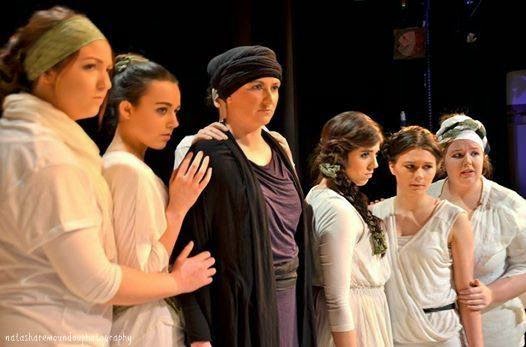As aspects of the design
for our production of Sophocles’
Electra (adapted by
Frank McGuinness) evolve and move closer to what will be the final build, I
thought it would be interesting to take a look at the immediate similarities
between our set design and what historians have to say about the staging of
Greek Theatre over 2600 years ago. According to The Oxford Illustrated
History of Theatre (Brown, 1995.), the Greek open-air theatre was first a
circular, levelled performance space (orchestra = dance-space)
located in the hollow between two hillsides. The whole area was known as the theatron
— the spectacle-place or viewing-place.
The orchestra was
normally circular. It was a level space where the chorus would dance, sing, and
interact with the actors who were on the stage near the skene. In the
centre of the orchestra there was often a thymele, or altar.
By 465 B.C. a small wooden hut or tent called a skene
(hence, scene), in which the actors changed costumes, was erected behind the
playing area. The skene was directly in back of the stage, and was
usually decorated as a palace, temple, or other building, depending on the
needs of the play. It had at least one set of doors, and actors could make
entrances and exits through them. There was also access to the roof of the skene
from behind, so that actors playing gods could appear on the roof, if needed.
Interestingly, it is thought that Sophocles may have been one of the first to
propose backdrops and such elaborate decorations for the theatre.
The floor in front of the skene was elevated, with steps
leading down to the orchestra, where the chorus was located; this narrow
playing level was called the proskenion (hence, proscenium) whereas the parodoi (passageways) are the paths by
which the chorus and some actors (such as those representing messengers or
people returning from abroad) made their entrances and exits. The audience
also used them to enter and exit the theatre before and after the performance.
Whether it was unintentional or a design choice, our theatron
and orchestra bears strong similarities:
Our chorus enter using the paradoi / pathways which also
allows the audience to enter and exit. Our thymele / altar is downstage
centre in the middle of the orchestra. We have developed a proskenion
/ proscenium on the audience floor level for entrances, exits and some
stage action but mostly as a space that frames the action of the play. Upstage,
we move up a level towards a skene / scene which acts as the exterior
walls of The House of Aegisthus. It contains a door through which the
majority of the titled characters make an entrance, exit or both. The skene
will be painted and decorated accordingly. Lastly, the knowledge that Greek
theatre was performed in the open air amidst the elements is an immediate parallel
to our context of being in the Burren - the rough, the wind, the birds
overhead, the sea, the waves crashing against the beach - all of those natural
elements which would have had some kinaesthetic and topographical influence on
the performance.
I find it very interesting how Greek theatre, similar to
Shakespeare perhaps, lends itself to be relocated elsewhere in history / the
World (location, time and context) very easily however, it retains the staging
conventions it was originally conceived with. Sophocles and his contemporaries
understood how to involve an audience (remember, their audiences were
estimated to be close to 14000 people) through creating stimulating images
on stage, use of colour, shape, levels, heights and postures. More so, they had
a deep understanding of how to use the stage and the aforementioned elements to
both shape and build the entrances and exits, poetry, tension
and dramatic action within the text. Even 2600 years later!
Paul Hannon
 |
| Our set in process. Set Design: Nelson Barre |
Reference:
Brown, John Russell. "1. Greek Theatre." The Oxford
Illustrated History of Theatre. New York: Oxford UP, 2001. 13-48. Print.



No comments:
Post a Comment